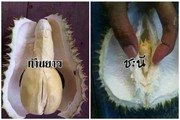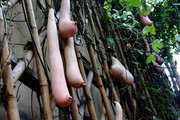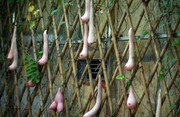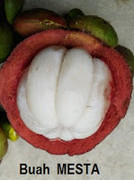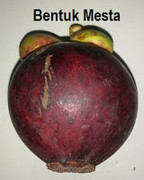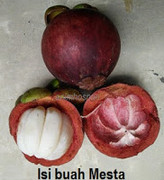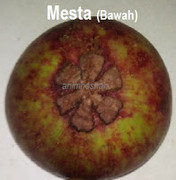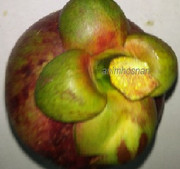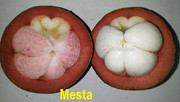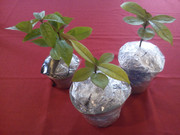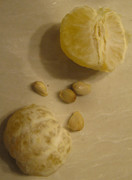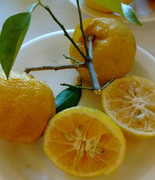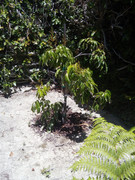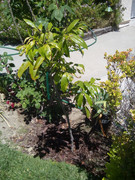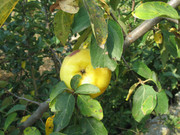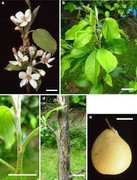Temperatures & Climate of PNW CitiesThe city of Olympia, WA happens to be farther north than Duluth, Minnesota. Heck, it happens to be farther north in latitude than Quebec City in Canada. (Don't believe me? Pull out a map)
And yet it is possible to grow some limited varieties of citrus here, and I'm not talking about those yucky borderline hybrids of Trifoliate Orange.
Firstly, temperatures. Olympia is in climate zone 8a. Winter nighttime lows tend to be 27F at the lowest. Looking back at temperature records, there were two separate 3-day stretches where the nighttime lows dipped down to 19F. These nighttime lows were all preceded by sunny days where there wasn't the cloud cover and marine influence that helps moderate the temperatures. So ironically, if you see an anomalous sunny day during the coldest part of winter, watch out! That's probably when the plants are going to need protection that night.
Ironically as you head just an hour or two north you move into climate zone 8b. This is because Tacoma and Seattle sit right against the sound and all that water helps moderate the winter low temperatures. In Olympia, by contrast, a lot of the marine air from the coast has to move over 50 miles of land, and by that time has had a chance to cool down a few degrees. That's not to say Olympia doesn't get any influence from the sound, but the city sits at the very end of the sound, where it's narrower, and ends up not getting as much influence from it. So Olympia may get just a week of light snow in the winter whereas Tacoma may get nothing. Probably the spot with the most moderate winter temperatures is Point Defiance, which juts out into the sound. Not surprisingly there's a plant nursery named Jungle Fever exotics located here.
The overall climate in Olympia and Seattle is not that different, but there are some differences. Olympia tends to have slightly hotter summers. Olympia also has slightly less sunny days per year, though the difference is very slight. Olympia gets a little more rainfall, since Seattle is subject to some extent to the rain shadow effect from the Olympic mountains. Seattle does have slightly higher winter lows than Olympia, both because of its location and because of the extensive urban development in the region. As we move further north into Vancouver, Canada, the winter nighttime lows are yet higher still than Seattle. This is because Vancouver sits right on the water and gets more direct access to the marine influence from the Pacific Ocean (through the Strait of Juan de Fuca). Temperatures are overall about 2 degrees cooler in Vancouver than Seattle, it's just that the lows points tend not to be as low. Victoria, on Vancouver Island, is practically subtropical. Well, as close as subtropical gets in Canada. There's someone with a farm out there growing Meyer lemons! While it is really on the borderline of the temperature citrus can survive in, the huge amount of marine influence probably means there are not devastating cold spells that come along every so many years. This is the case in Olympia, which may occasionally have a winter colder than other years. You can grow regular varieties of pomegranates, but every 8 years or so there will be a devastating freeze that will freeze kill them all to the ground. (Slightly more cold-hardy varieties can survive though)
When you go south to Portland, the trend continues. Portland is warmer, but it's also further inland. This can sometimes mean freak hail storms some years. Overall, Portland probably has just a tiny bit colder lows than Olympia during the winter, but also warmer highs. Certainly it's warmer during the height of summer, where sometimes it can get uncomfortably hot for 2 to 4 weeks. It's worth pointing out here that Portland appears to be the northernmost extent of where roses seem to grow very well (hotter, dryer summers and the longer growing season).
It's fair to say that the temperatures are not a huge degree different from Portland to Vancouver (Canada) but there are some small but significant differences. More like an overall trend as you head north over this regional stretch. It's not a coincidence these major cities are located where they are. Usually going higher in latitude would make things colder, but in this case the major cities have progressively more marine influence as one goes north along this stretch, which helps counteract the difference in latitude.
In case you're wondering why the Northwest experiences much milder winters than the Northeast, it's because winds bring warmer ocean air inland. When it rains, that also helps prevent the temperature from going too low, because water vapor releases latent energy of heat as it condenses. The West coast tends to get most of its precipitation during the winter.
So the Pacific Northwest has mild winters. But it also has a short growing season. The winter lows might not be too bad but those temperatures don't start getting up to where citrus needs for growing until around May. And as much rainfall as the Pacific Northwest gets, the trees are probably still going to need some watering during the dry summers.
Citrus Varieties that can be GrownYuzu can definitely grow outside in the PNW. Bloomsweet grapefruit can be reliably grown with just a little bit of minimal protection during the winter, starting in late December. (Make sure the plant is grown indoors during the winter under a grow light, some place warm, and where the indoor humidity won't drop too low, for the first two years to give the plant a chance to get some time to become established, because young small plants usually are not able to survive cold very well, not until they get to 2 or 3 feet high)
Satsuma mandarins have been grown in Olympia, though they don't tend to produce very well without some minimal amount of covering.
Ichang mandarins or
Citrus taiwanica (Taiwanica lemon) should be no problem.
Some Overall Thoughts about the Historical World Movement of CitrusIt is ironic, from one standpoint. There are actually so many plants from Japan that are commonly planted in the PNW now. There's a fair amount of influence from Asia (particularly Northeast Asia) in the PNW region, which has come across from the other side of the Ocean. But cold-hardy citrus has not been one of this influences. Even in Southern California, virtually all of the citrus varieties came from Florida or, in a few number of instances, Texas.
The reason citrus has traditionally been viewed as a climate zone 10 fruit (or zone 9 at best) no doubt has to do with history and geography. While Asia was the heart of citrus growing, the traditional varieties that we are most familiar with were brought to Mediterranean Europe via the Muslims from India. Oranges were already growing in Spain before Marco Polo's journey to China, so since Europe already had oranges and lemons of their own, the citrus varieties in Asia were not seen as such a novelty. With the exception of pomelo which could never be grown in Europe. That would later get bred into grapefruit though, which could be grown in Florida and parts of Texas. America was settled from East to West, originally by peoples who came mostly from Western Europe, so this had a profound effect on the varieties of plants under cultivation. The particular varieties might not have been the most suitable to the lands being settled, but that's what they had, that's what they were familiar with. This in large part explains why the Mid-Atlantic Northeast was the first region to be primarily settled, because the climate was so similar to that of England and many of the same crops were suitable to grow there. It also explains why the Spanish were more successful at settling lands with warmer dryer climates more similar to their own (like in Mexico, Texas, and Southern California). Pomegranate and quince were traditionally viewed as warmer Mediterranean fruits. It was not until just two or three decades ago that new varieties of these fruits were brought to America from Southern Russia that were more cold tolerant and disease resistant in wetter climates. Although the Northwestern part of Europe has a cooler wetter climate, they were only familiar with the lineage of pomegranate and quince that had reached them from the Mediterranean, and this carried over into America as well. It's the same story with citrus, the citrus known in Europe were only those varieties that had originally been taken from China to India and cultivated in India (approximately climate zone 10).
Meanwhile, there were cold-hardier citrus being cultivated in remote parts of interior China, and in Japan cold-hardier citrus varieties were being bred (primarily from Yuzu that had been taken from China).
Oranges were probably quicker to culturally disseminate over long distances, gradually making their way to Europe, than mandarins were (despite mandarins being the more cold-hardy of the two) because oranges have a thicker rind and longer shelf life, so the fruit could survive a longer journey, to be tasted by someone else from another culture. Of course the citron was known in the Middle East since ancient times. Just had to add some historical perspective in this post.
On the subject of Bloomsweet and its origins from Japan, please see my post in this thread: "Bloomsweet"
http://tropicalfruitforum.com/index.php?topic=22785.0 (it happens not to be posted in the Cold Hardy Citrus section which is why I'm giving you this link)
Thoughts on why the idea of trying to grow Citrus in the PNW never became popularWell anyway, back on topic. While there has now been plenty of experimentation in Northern Florida, Texas, Georgia, and South Carolina growing citrus varieties outdoors, there is virtually no one in the Pacific Northwest growing citrus outdoors, despite the PNW being in the same official climate zone range.
And despite the PNW actually being much closer to the region of the world where all these cold-hardy citrus varieties came from (Japan and China). That's what I find so ironic.
Perhaps it's because all these areas (FL, TX, GA, SC) are so close to the citrus growing region in Florida. Whereas the PNW is so far away from Southern California, and in any case most of the citrus growing around the coast of California has since been destroyed due to the high land costs due to high population growth in that region. The commercial citrus growing in California has been pushed far inland, but then it can only go so far north before the winter lows get too cold.
So someone in South Carolina has commercial citrus groves growing a few hundred miles South of them, whereas someone in the far northern part of California has the San Francisco Bay area to the South of them. And then there are the coastal mountains in the northern part of the state, which means that the citrus growing would have to be very close to the coast, but then there is also all that coastal fog and clouds. It doesn't have those high temperatures and sunny weather citrus plants like. So I suppose the economics and geography on the West Coast are not as continuous as on the East Coast. On the East Coast it's merely a matter of temperature as you begin heading north from the Florida citrus belt. The region is much more flat, and surrounding land costs lower in the area we are talking about. What I mean is that, when you stop and think about it the reasons become pretty plain as to why there has been such little attempt at trying to start taking citrus northward on the West Coast; it's not such a natural progression or obvious inclination.
So maybe to summarize this post, there are reasons for everything, if we really want to examine them, but sometimes those reasons are kind of complicated.
I have so many thoughts here, hard to stay on one topic.

